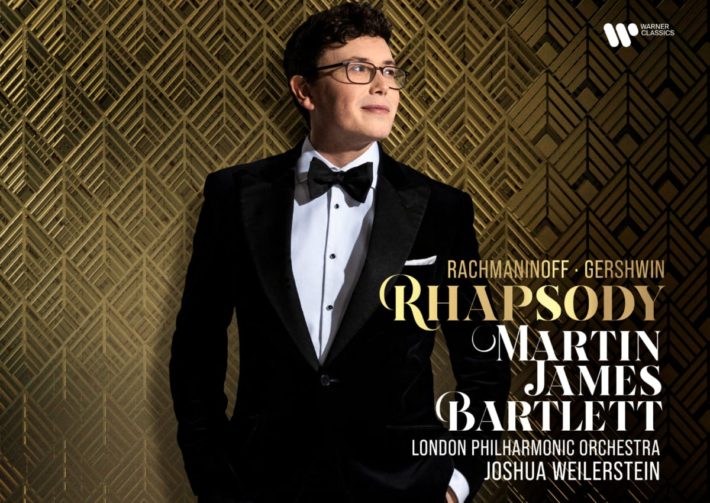Aside from being contemporaries, Rachmaninoff and Gershwin share a number of interesting commonalities. Their respective Rhapsody on a Theme of Paganini and Rhapsody in Blue both possess an unforgettable lyricism and certain parallels in structural treatment. A glance at the track listings yields yet another connection but through a different composer: Earl Wild. Wild transcribed Rachmaninoff’s Vocalise among other works and used Gershwin’s songs as an inspiration for his 7 Virtuoso Etudes. Martin James Bartlett himself has featured both Rhapsodies at prominent moments in his own career. He won the 2014 BBC Young Musician of the Year competition with the Rachmaninoff and performed the Gershwin in his BBC Proms debut the year after.
The first A minor section of the Rachaninoff offers a good amount of clarity on several levels. Vivacity comes alive through Bartlett’s crisp articulation and peppery staccatos. The rustling of the violins (Var. 3) creates not only a nice backdrop for the wind figurations layered on top but also offers contrast to the piano’s more legato texture. The continuity between the piano and bassoon (Var. 7) offers a glimpse into the smaller threads of conversation Rachmaninoff weaves throughout but could use a little more refinement: the bassoon needs more prominence given its importance, and Barlett’s phrases would benefit with a bit more color. Trifonov, in his DG version with the Philadelphia Orchestra, gets the instrumental balance just right, and the pianist‘s refined dynamic gradients create a lyricism despite the largely static, chordal texture.
The middle sections introduce the Rhapsody’s other vibrant personalities. Var. 14 has plenty of oomph thanks to the London Philharmonic’s solid brass section. In Var. 15, Bartlett impresses with his runs: accompanying the aforementioned clarity are now a mellow tone and playfulness. In the iconic D-flat major variation (Var. 18), the pianist is obviously going for sensitivity and leaving room for a long-term buildup (which is excellently done). But for its beauty, I feel Rachmaninoff’s writing calls for a much fuller sound right off the bat. I reviewed a performance in April 2020 by Behzod Abudairov and the Lucerne Symphony, and I heartily prefer this interpretation for its richness as well as how Abduraimov gives an organic fluidity to the lines.
Related Posts
- Review: “Summertime” – Isata Kanneh-Mason, Piano
- Review: “Destination Rachmaninov – Arrival” – Piano Concertos No. 1 & 3 – Daniil Trifonov
- Review: Rachmaninoff – Symphony No. 2 – London Symphony Orchestra, Rattle
The Rhapsody in Blue presented here is the second symphonic scoring by Ferdé Grofe (his first is largely considered the gold standard and was used in Gershwin’s own 1924 premiere–which Rachmaninoff attended). Barlett opted for this particular version with its connection to Earl Wild, who premiered it in 1942 with Toscanini and the NBC Symphony.
The first thing we anticipate, of course, is the clarinet solo. Regretfully, this one misses the mark: the sliding glissando hydroplanes much too quickly and the ensemble’s slow tempo loses the work’s slinky jazz vibe. (Benny Goodman plays on the Toscanini/Wild recording, and with better results: his longer-than-usual trill builds suspense, and the glissando–a scale, not a slide–floats perfectly up to the high B-flat. Toscanini’s tempo is far brisker, but this is key to maintaining the energy.) I felt that overall, the performance needed more boisterousness, humor, and fun to make it truly enthralling. But despite being a little too suave, the finale does it justice. The sweeping reprisal of the main theme shows an orchestra on full blast; Bartlett does his part with full-bodied chords and takes the appropriate time to let us savor the final moments.
Among the solo works, I very much enjoyed Wild’s Etude No. 4 after ‘Embraceable You’ (track 31). Wild adds to Gershwin’s melody an additional layer of textural filigrees and lush cascades of scales. In addition to showing a complete comfort with the technical demands, Bartlett brings a soothing aspect to the romanticism: the melody never falters in its continuity, warmth, and vocal quality. The high point, passionate and radiant, brings the virtuosity full circle.
The liner notes are relatively short, but the balance is good: concise introductions to the works leave most of the room for insight on the connection between the composers as well as the thematic basis of the album. As for the sound engineering, I found it a little up-close at times, but it wasn’t always a bad thing. In many cases, I was able to pick on textural details that added to the performances. An attractive choice of works and overall solid performances more than make up for the few misses – an enjoyable listen.

Rhapsody
Martin Jamese Bartlett – Piano
London Philharmonic Orchestra
Joshua Weilerstein – Conductor
Warner Classics, CD 9029643433
Recommended Comparisons
Read more classical music reviews or visit The Classic Review Amazon store
Follow Us and Comment:
[wd_hustle id=”HustlePostEmbed” type=”embedded”]











